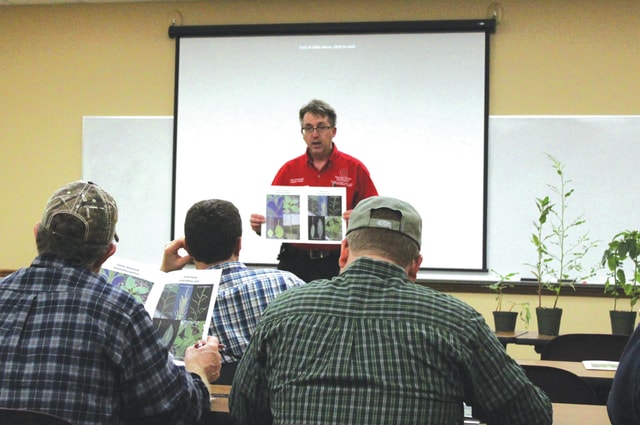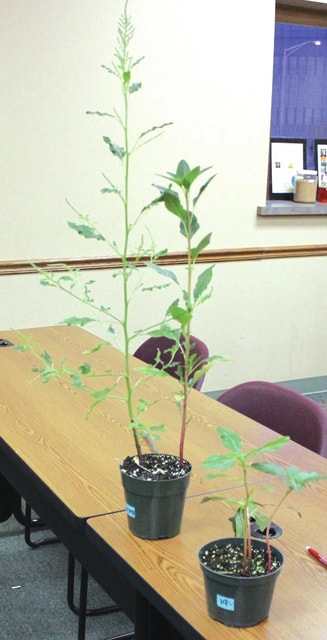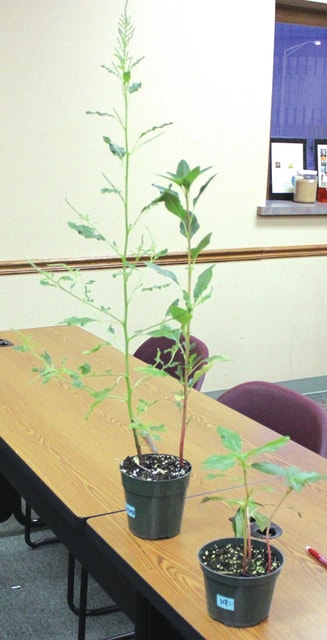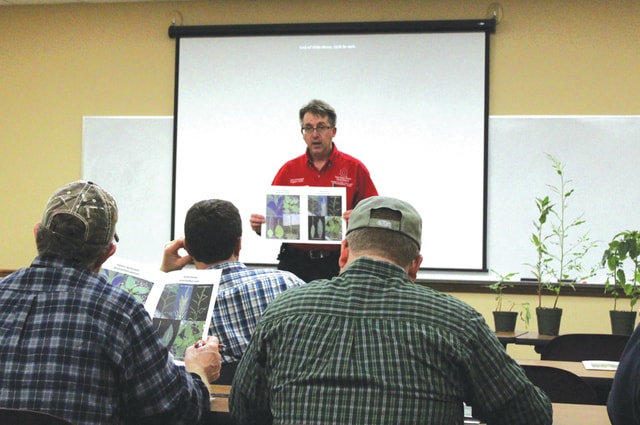



DARKE COUNTY — Anyone who owns even a small plot of earth hates weeds. For farmers, however, weeds are a bigger concern than mere aesthetics.
One weed in particular is causing concern among local agriculture producers.
Waterhemp (scientific name Amaranthus rudis “common waterhemp” or Amaranthus tuberculatus “tall waterhemp”) is becoming an increasing problem for West Central Ohio farmers.
Dr. Jeff Stachler, extension educator in Auglaize County, met with agriculture producers Tuesday to discuss the issue, as was Dr. Mark Loux, professor at Ohio State’s Department of Horticulture and Crop Science. The meeting was held at the Andersons ethanol plant in Greenville.
Stachler said last year that he and Sam Custer, Darke County extension educator, did an 80-mile loop around Darke County to survey the fields, and more particularly, weed infestations in the fields. They characterized what they found as “a lot of weeds,” including waterhemp.
They found 25 percent of the fields in Darke County in 2016 had waterhemp, with most of the infestation located in the northern and western portions of the county. Thirty-two percent of fields in Auglaize County and 28 percent in Mercer County had waterhemp.
In all, only 13 percent of Darke County fields in 2016 were classified as “weed free,” down from 34 percent in 2014.
The presence of waterhemp is spreading. In 2013, waterhemp was present in nine Ohio counties. As of 2016, it had spread to 26 Ohio counties.
“The hotbed is here in West Central Ohio,” said Stachler. “In East Central Indiana, there’s quite a bit of it as well, which is where some of it came from.”
“I’m not saying that all the waterhemp we’re seeing is glyphosate resistant, but I’d say about 11 percent of the fields are resistant, because those fields just had waterhemp in them, or had waterhemp, giant ragweed or marestail in them,” Stachler said. “If those weeds are present in addition to the waterhemp, there’s pretty good odds they’re resistant to glyphosate as well.”
Waterhemp is a pernicious weed, not only because of its resistance to herbicides, but because of the number of seeds it produces. Most plants produce 100,000 seeds, some up to 250,000 seeds, while it’s possible for extremely large plants to produce more than a million seeds.
Because waterhemp is “dioecious,” meaning there are male and female plants, it increases the weed’s genetic diversity, which gives it greater resistance to herbicides. Stachler calls it the “biggest concern” on how to manage the weed.
“It’s probably more genetically diverse than any other weed out there with the exception of a Palmer amaranth,” said. “Both are extremely genetically diverse.”
Stachler showed the group in attendance live samples of both waterhemp and Palmer amaranth, and explained the physical characteristics that distinguish them.
Identifying waterhemp is one thing. Getting rid of the weed is quite another.
Dr. Loux says because waterhemp can infest a field rapidly and emerges well into the growing season, control requires a very comprehensive herbicide program.
“It also develops resistance to herbicide sites of action more rapidly than about any other weed we deal with in row crops,” he said. “So after it develops resistance to one site of action that a producer has been relying on, and he then relies on another one too much, it develops resistance to that also. So a grower can run out of options to manage waterhemp.”
“We don’t usually talk about ‘eliminating’ weeds like this since once there’s a soil seed bank, that’s not much of a possibility,” Loux explained. “Control requires a combination of preeemergence residual herbicides applied before or at planting, to control newly emerging waterhemp for a month or so, followed by postemergence herbicides applied to emerged soybeans or corn, when the residuals wear out and there are enough small waterhemp to require treatment.”
If herbicide application fails, another option is to simply pull the plants by hand, but this should be done with caution, he said.
“You can pull them out and remove them from the field, preferably before they have mature seed, and this is a good way to prevent new infestations or ensure complete control following a less than completely effective herbicide program. Once they have seed, handling them too rough and dragging them out of the field can certainly spread seed. cutting seedbeds off and bagging them prior to removal can be one method once they have mature seed,” Loux said.
For further information on weed control efforts in Darke County, contact Sam Custer at the Darke County Extension Office by phone at 937-548-5215. In Auglaize County, contact Jeff Stachler by phone at 419-739-6580.






